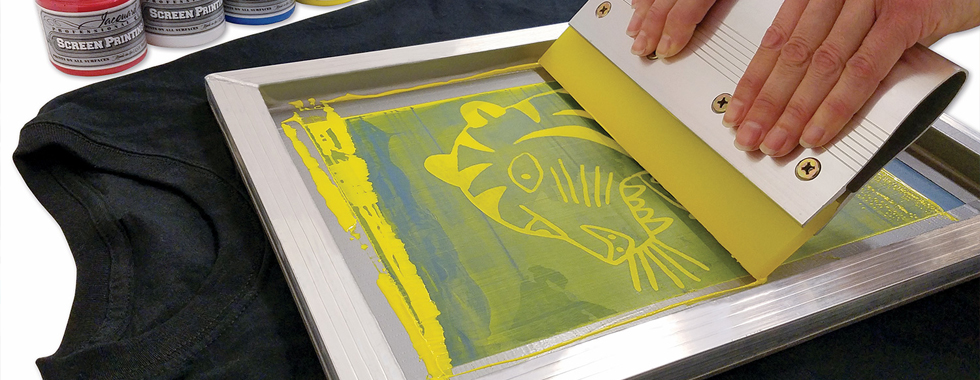The Vital Guide to Comprehending Screen Printing and Its Versatile Makes use of
Screen printing has an abundant history that dates back to old times, developing into a sophisticated technique used across numerous industries today. This guide discovers the ins and outs of the screen printing process, outlining its applications in fashion, marketing, and home design - 10:9 Design reviews. Comprehending these principles can open imaginative possibility for both commercial and creative tasks. The following sections will reveal vital pointers and techniques to enhance one's screen printing undertakings
The Background of Screen Printing
Although screen printing has origins that map back centuries, its advancement mirrors the creative and technical advancements of numerous societies. Coming from ancient China, the method was initially used for embellishing textiles and later spread to Japan, where it came to be important to Ukiyo-e woodblock printing. The method moved to Europe in the 18th century, where it obtained popularity among artisans and industrial printers. The innovation of photo emulsion in the 20th century reinvented screen printing, permitting more complex styles and greater effectiveness. Artists like Andy Warhol further moved its popularity, using the tool to create legendary works that mixed commercialism and great art. By the late 20th century, screen printing had actually developed itself as a flexible strategy, employed in style, advertising, and fine art. Today, it remains to advance, incorporating digital technology and broadening its applications across different markets.
The Screen Printing Process Explained
Screen printing changes artistic visions into concrete layouts with a series of precise steps. Initially, a picture is produced and after that transferred onto a screen, usually made from great mesh fabric extended over a frame. A light-sensitive emulsion is applied to the screen, which is revealed to light, hardening in locations not covered by the image. After washing out the unhardened solution, a pattern is developed.
Next off, the screen is put over the substratum, whether it be fabric, paper, or one more product. Ink is after that pressed with the open areas of the pattern using a squeegee, depositing the style onto the substratum below. This process can be repeated for several shades, requiring different displays for each and every shade. The printed thing is cured utilizing warmth to ensure the ink adheres appropriately, resulting in a durable, vibrant style ready for usage.
Kinds Of Screen Printing Techniques

Additionally, specialty methods, such as discharge screen printing, get rid of dye from the textile to produce softer prints, while aluminum foil screen printing applies metal foil to attain a glossy coating (10:9 Design Texas). Each technique offers distinctive features, accommodating different imaginative needs and production ranges, inevitably broadening the opportunities within the screen printing domain name
Applications of Screen Printing in Various Industries

In addition, the signs and marketing sectors use screen printing for producing captivating displays and banners. This technique permits bold colors and complex styles that capture attention. In electronics, screen printing is employed for using conductive inks to motherboard, crucial for element links. The home design sector accepts screen printing to create unique designs on fabrics and wall art. On the whole, screen printing acts as an essential tool throughout varied fields, improving items with customized and aesthetically enticing graphics.
Tips for Effective Screen Printing Projects
While undertaking a screen printing task, mindful interest to information can substantially boost the final outcome. Choosing premium products is essential; this includes the screen, inks, and substratums. Utilizing proper mesh matters can impact ink deposition and detail resolution. Preparation is just as vital; comprehensive cleansing of displays and proper exposure times assure crisp prints.
Next off, exact registration is critical for multi-color prints. Making use of alignment tools can aid accomplish specific layering. In addition, screening prints on scrap products before manufacturing aids recognize prospective concerns without wasting sources.

Regularly Asked Concerns
What Materials Are Finest for Screen Printing on Textile?
Cotton and polyester blends are suitable for screen printing on material due to their toughness and ink absorption. Furthermore, specialty textiles like silk or canvas can create one-of-a-kind appearances and coatings, enhancing the overall design quality.
How Do I Tidy and Maintain Screen Printing Devices?
To cleanse and maintain screen printing tools, one should on a regular basis wash displays with appropriate solvents, evaluate squeegees for wear, lube relocating components, and shop all things in a dry, dust-free setting to extend their life expectancy.
What Are the Environmental Impacts of Screen Printing?
Screen printing can have substantial ecological impacts, consisting of chemical waste from solvents and inks, water usage throughout cleansing processes, and energy consumption. Green materials and sustainable techniques are important for minimizing these adverse impacts.
Can Screen Printing Be Done in your home Successfully?
Screen printing can be efficiently done at home with the best products and click here strategies. Hobbyists can create quality prints, though success depends on their skill level, devices, and understanding of the process involved.
What Are the Prices Associated With Beginning a Display Printing Business?

Starting a screen printing organization involves expenses for tools, materials, and office. First expenditures normally range from a few hundred to several thousand dollars, depending on the scale, high quality of machinery, and preferred manufacturing ability.
Screen printing has a rich history that dates back to ancient times, advancing right into an innovative strategy utilized throughout different markets today. Another method, rotary screen printing, employs round displays, assisting in continual printing on material rolls, therefore improving performance for large-scale productions. In addition, specialized techniques, such as discharge screen printing, eliminate color from the textile to develop softer prints, while aluminum foil screen printing uses metallic foil to accomplish a shiny finish. In the style sector, screen printing is commonly made use of to produce vivid designs on garments, enabling brand names to showcase their distinct designs. Cotton and polyester blends are excellent for screen printing on fabric due to their sturdiness and ink absorption.